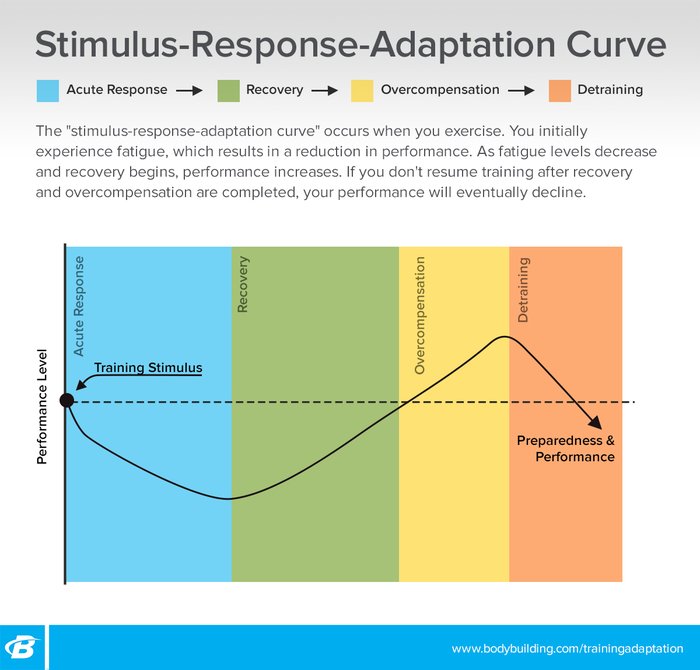Here's something that makes sense on the surface, but is very, very hard for many trainees to grasp: The stronger you are, the more your workouts will mess you up.
Think about it: When Layne Norton deadlifts 500 pounds for 10 reps, it takes a far greater toll and necessitates more recovery time than when you (please don't take this personally) deadlift 185 for 10. Yes, I know; a hard set of 10 is tough no matter how weak or strong you are, but you'll be hard-pressed to convince me that 1850 pounds of work requires the same amount of recovery time as 5000 pounds.

So how do you get from point A (you) to point B (Layne)? Or put another way, how can we use this sort of objective information to figure out when you're subjectively recovered and ready to train a movement or muscle group again?
Of course, you'll find coaches that run the gamut, from "squat every day" to "squat when you can't remember the last time you did it." Here's what I've found to work best throughout my career.
The 100 Pounds/24 Hours Recovery Rule
In my experience, the following rule of thumb is a great way to start envisioning recovery and training frequency: Most lifters need a minimum of 24 hours to recover from strength training, and another 24 hours for every 100 pounds on the bar during a hard working set. Here are a few examples:
- Nancy can do 4 sets of 10 with 35-pound dumbbells on the dumbbell bench press. Recovery time: 24 hours
- Erica can squat 135 pounds for 5 sets of 5. Recovery time: 48 hours
- Tim can incline press 245 pounds for 4 sets of 6. Recovery time: 72 hours
- Josh can deadlift 265 pounds for 6 sets of 3. Recovery time: 96 hours.
- Benni Magnusson can deadlift over 1000 pounds. Recovery time: Over a week.

Of course, this is just the start of the conversation. There are also factors related to specific movements, muscles, and populations:
- The hamstrings are more or less the biceps of the leg, but hamstring-intensive workouts require longer recovery times than biceps workouts.
- Bench pressing 10 reps with your 10RM requires less recovery time than squatting or deadlifting 10 reps with your 10RM.
- Bench pressing 10 reps with 225 requires a longer recovery than floor pressing the same weight for 10. Why? Less ROM means less work.
- A 56-year-old guy benching 225 for a set of 8 needs a longer recovery than a 23 year-old guy doing the same thing.
Now, a few points of clarification on these estimates: First, recovery times are affected by a number of factors, including not only age, but also nutrition habits, sleep quality, muscle-fiber-type makeup, work and family obligations, and so on. I can't quantify any of that for you without meeting you, sorry.
Second of all, the total training schedule must be considered. A lifter who only competes—and therefore, trains for—deadlift-only competitions can train the deadlift more frequently than his identical twin brother who is training ambitiously for all three big lifts.
Finally, taking sets to or near failure necessitates longer recovery times than leaving a few reps in the tank on most sets.
Even with these caveats, the basic rule remains: The stronger you are, the less frequently you should train any given exercise. The next question, then, is this: How do you use that information to actually get stronger?
Finding the Optimal Training Frequency
For anyone out there who's been wondering if they should trade in their customary whole-body workouts for the new-car smell of an upper-lower split, or vice-versa, let's dig into the details.
If your max bench is 195 pounds, and you can do 5 chin-ups on a good day, your upper-body exercises require perhaps two days of recovery. So, if you use an upper-lower split where you train your upper body once every 4-5 days, you're not taking full advantage of what's called the stimulus-response-adaptation curve, or SRA.

In short, once you present the target muscles with a stimulus in the form of a workout, your body initially struggles to adapt to the challenge, but, provided you allow enough recovery time, you supercompensate and become stronger than when you started. However—and spoiler alert, this is why you shouldn't use upper-lower splits unless you're pretty strong—if you wait too long, your strength levels fall back to their original levels.
This means if you wait long enough, you'll be starting all over again from scratch every single workout. If you train too frequently, however, you'll actually tend to get weaker with each new workout, because you're not allowing yourself to recover.
As with most things in life, the trick is finding the sweet spot between these two extremes.
Split or Full-body?
There's an old standard that coaches and gym rats have long used as a measure of "strong": the 1200 Club. That's a 300 bench, a 400 squat, and a 500 deadlift. I've long used this standard as a way to assign the appropriate type of training split when barbell strength is the goal.

Sure, there are athletes who end up being exceptions, but I suggest trying this rule before you start breaking it: Lifters who bench less than 300, squat less than 400, and pull less than 500 should perform full-body workouts about three times a week.
Monday
Wednesday
Friday
Just to be clear, that doesn't mean you should squat or deadlift every workout; it just means that both upper- and lower-body muscles should get hit roughly three times a week. Here's a quick hypothetical example of what that might look like:
Once you've graduated from the 1200 Club, it's probably time to consider a different type of training strategy: the upper-lower split. The stronger you get, the more recovery you'll need from your workouts, and the upper-lower split provides just that.

Here's a sample week:
Monday
Tuesday
Thursday
Friday
Notice that although each body region is trained less frequently than in whole-body workouts, you're actually training more frequently overall. And by this point in your strength career, you should be able to handle it.
You're Not a Master Until You Master the Basics!
Start with the examples I've outlines here, and over time, as your understanding increases, you'll be able to devise unique solutions based on your own evolving needs and circumstances. Build a strong foundation, and then feel free to improvise on top of it.

